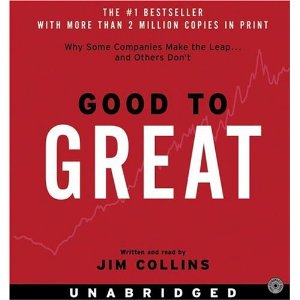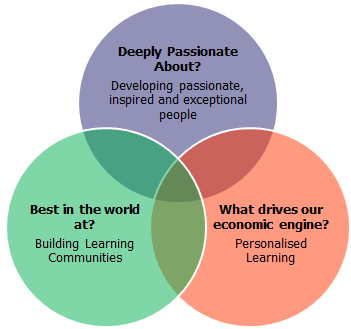Developing 21st Century School Leadership
- On 04-03-2011
I have realised over the past 6 months how few schools are actually clear about what their long term vision is. Part of the impact of this lack of vision and disciplined building of this vision is that schools can quite often be focussed on things that disperse their power and ability. They become like a thirsty person wandering in the desert – going from one mirage to the next. Teachers become inured to change and morale can suffer.
In an increasingly competitive educational and financial environment, and as part of the paradigm shift occurring as we move further into the Information Age, it has become critical for schools to be clear and focused in their vision and actions. Even more so is to develop a culture of disciplined people, disciplined thoughts, and disciplined actions.
There are a number of steps to this process including
- Empowering Level 5 Leadership (as Jim Collins speaks of in “Good to Great”)
- Getting the right people on the bus – getting a strong core group of leaders within the school who will be the team who will take responsibility to create and build the vision within the school community
- Creating a hedgehog concept for the school
- Creating clearly what it means, what it feels like, what it looks like when that hedgehog concept is accomplished
- Creating the non-negotiables as you move forward
- Confronting what is actually the current state of the school – what is working, what is not against the vision, mission statement, or hedgehog concept.
- And so on
What I want to share about this blog is how we worked with a leadership team at a school to create the hedgehog concept and began the process of uncovering their collective meaning, vision and actions to deliver on that vision.
A Hedgehog concept is idea that Jim Collins shares about in his book “Good to Great”. The idea comes from the story that the hedgehog succeeds because is only good at one thing – it rolls itself up into a ball with its spines outwards and it is protected against any dangers (such as foxes who have to come up with many strategies to succeed but rarely ever do). What Jim Collins found is that the most consistently successful organisations follow this concept as well. They adhere fanatically to their vision (Hedgehog Concept) and ignore taking on anything not consistent with it. This gives them an ability to remain focussed and able to develop consistent structures, approaches and culture.
There are three elements to the hedgehog concept:
- What can you be the best in the world at?
• Understand what you can and cannot be the best at
• Let your abilities, not egos, determine what you attempt
- What drives your economic engine?
• What has the greatest impact on your economics (reputation for a school)?
- What are you deeply passionate about?
• Great organisations focus on those activities that ignite their passion
You can see in the diagram below the result of doing this work with a school.
Some of the discussion that raged as the leadership team created the 3 elements was fascinating
- In distinguishing what they were deeply passionate about the team really cottoned on that this was not just a statement for students or learning but their bigger vision for all people. They wanted everyone (teachers, students, parents, etc) involved with the school to be exceptional, inspired and passionate. We toyed with the idea of “the best they can be” but distinguished this was limiting. How do we even know what people’s best is? We toyed with extraordinary but that is a quite oft used word that has lost its meaning for many. This led to exceptional – an exception to the norm.
- The team wanted to be the best in the world at building learning communities. I confronted the group this week to define what that actually meant. In the first few minutes of discussion it was interesting to note that different people had different conceptions about what that meant or looked like. WE spent most of the session doing the work to be really clear about what that meant. Here is what they created:
Groups of people with a common goal / vision
Working collaboratively (learning from and together)
Removing mediocrity
Developing 21st century social competencies
Inspiring passionate and exceptional people
- The leadership team had to define some not-negotiable items in the shifting of the school to deliver its vision. These included:
o Working collaboratively
o Removing mediocrity
o Passion and Professionalism
o High levels of literacy and numeracy
o Making informed decisions on student learning
o Developing 21st century social competencies
o Every child matters
o All aboard or not on board
In the whole process it became clear that as questions and ideas arose it pointed to that certain structures, systems and thinking had to be embedded in the staff (including having the staff plan for delivering social competencies first and then strategically looking at the content to be covered and discussing how the content be used to develop the competencies).
The homework the leadership team is now working upon is to become clear about what each aspect of the hedgehog concept means and what it looks like. They will also share with another staff member who they consider to be a leader within the staff community. The purpose of this is to start enrolling the staff in a future being created and to ignite feedback and leadership. Finally, against the future and vision they have created, they will outline where they are now in that journey. This will allow us to plan the steps to achieve that future.


0 Comments